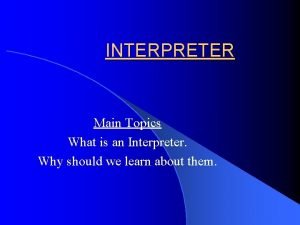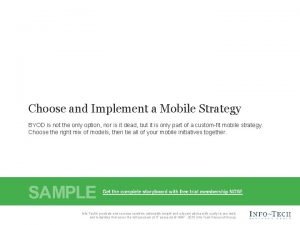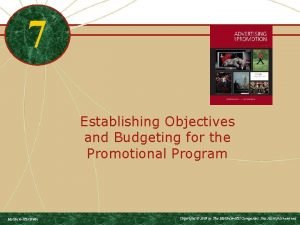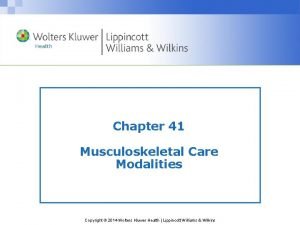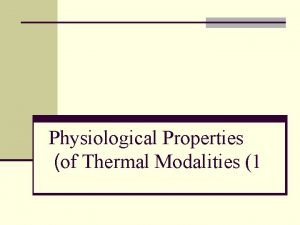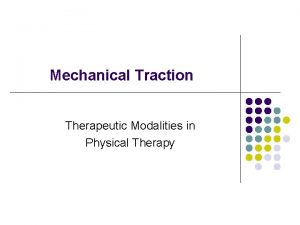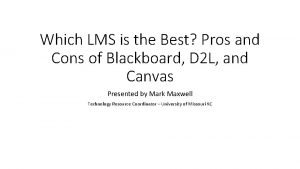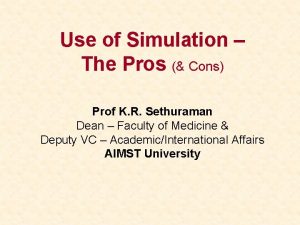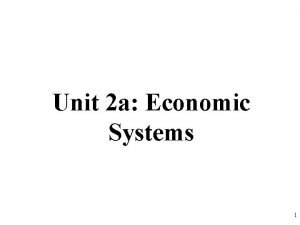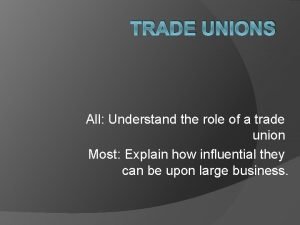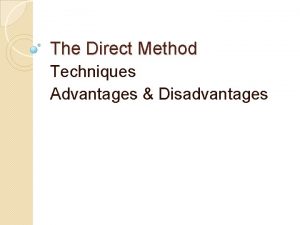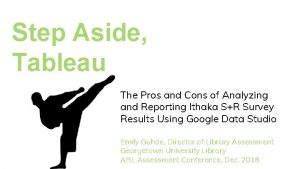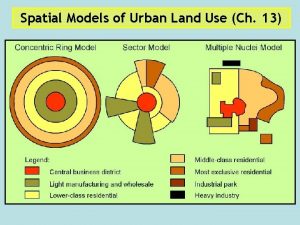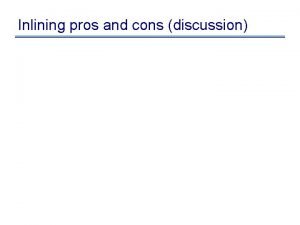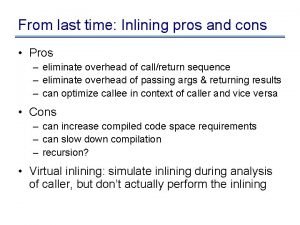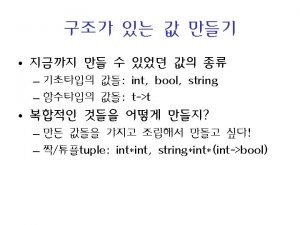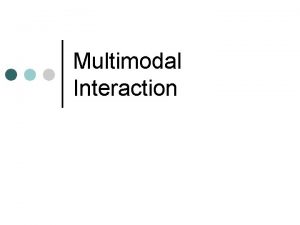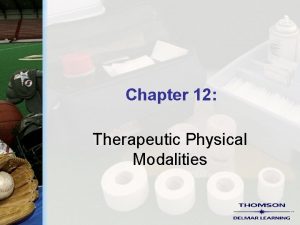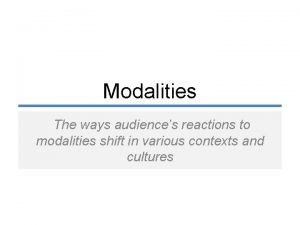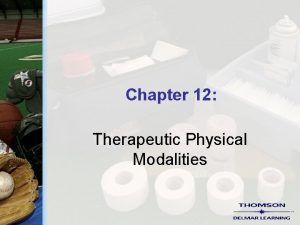Survey Experiment Modalities Some Pros and Cons of



































- Slides: 35

Survey Experiment Modalities Some Pros and Cons of Differing Sampling Sources and Methods Matthew A. Baum Harvard University & Leonie Huddy Stonybrook University

Outline Review of prominent Internet players Amazon Mechanical Turk Knowledge Networks Yougov/Polimetrix Survey. Monkey Audience Comparing survey modalities USA vs. Swedish Phone/Internet Usage Statistics Conclusions

Amazon Mechanical Turk (AMT) Overview Began in 2005 “Workers” sign up to participate in tasks for pay (called “Human Intelligence Tasks”, or “HITs”) Global workforce (~100, 000 workers) Salary: ~$3 -$8/hour (maybe $10/hr for high-experience workers) “Requestors recruit “workers” on internal message board describing task Can specify “qualifications” for workers (e. g. , experience, quality ratings, nationality, etc. ) 10% fee to Amazon AMT provides survey building tools, or Requestors can include links to external surveys HITs range from 1 -second marketing surveys (“Rate appeal of this photo on 1 -10 scale”) to elaborate 30+ minute experimental surveys

Amazon Mechanical Turk (AMT) Effects of Compensation Amount and Task Length on Participation Rates (Submitted Surveys per Hour of Posting Time) Compensation Amount Short survey (5 min) Medium survey (10 min) Long survey (30 min) $. 02 5. 6 5. 3 $. 10 25. 0 14. 3 6. 3 $. 50 40. 5 31. 6 16. 7 Source: Buhrmester, Kwang, and Gosling (2011) My AMT Experience: • paid $1. 00 per completed HIT for ~22 minute survey • Listed as “News and Politics Survey” • Received 1933 completed surveys in ~one month • rapidly diminishing returns • 1825 valid responses

Amazon Mechanical Turk (AMT) Demographics Buhrmester, Kwang, and Gosling (2011) % Female % Non. White % Non. American Age AMT 55 36 31 32. 8 Internet 57 Fewer (? ) ~31 24. 3 Paolacci, Chandler, and Ipeirotis (2010) Category (N=1000 AMT workers) % Female 64. 9 Average Age 36 % Earning below $60 k/year 66. 7 Education “higher than general pop. ” % Non-American 53

Amazon Mechanical Turk (AMT) Demographics My AMT Survey (N=1824) US National Averages (From Pew 2010 Survey) Average Age 32. 6 51. 0 % Non-White 12. 2 20. 3 % Female 58. 2 56. 9 % Democrats 37. 4 31. 9 % Republicans 17. 7 28. 0 % Independents 44. 3 40. 1 % Liberal 36. 7 17. 5 % Moderate 46. 9 43. 9 % Conservative 16. 3 38. 6

Amazon Mechanical Turk (AMT)

Follow-Up Survey Contacted all 1825 workers who completed valid HITs in original survey approximately 4 months later Offered $. 50 for ~12 minute survey 426 valid responses (24%) 2 nd batch of invites

Tradeoffs Source: Paolacci, Chandler, & Ipeirotis (2010)

Some Conclusions re AMT “Our analyses of demographic characteristics suggest that MTurk participants are at least as diverse and more representative of noncollege populations than those of typical Internet and traditional samples. Most important, we found that the quality of data provided by MTurk met or exceeded the psychometric standards associated with published research. ” Buhrmester et al. (2011) “Our theoretical discussion and empirical findings suggest that experimenters should consider Mechanical Turk as a viable alternative for data collection. ” Paolacci et al. (2010)

Knowledge Networks 2007 Survey (via TESS) Participants recruited via residential address searches Respond online (Internet access provided to recruits who don’t have it) Pretty good samples, but imperfect (selection effects not completely purged) and expensive Demographics Post-Survey Matched Sample (N=1014) % Female 50 % Non-white 26. 7 % Liberal 25 % Moderate 41 % Conservative 33 Average Age 46 Ideological Intensity (0 -3 scale) . 99

Recent (2012) KN Proposal • Design: 4 -wave study, longitudinal sample, all waves occurring within 1 year • Pretest: N=25 interviews each wave • Sample: General population adults, age 18+, English-language surveytakers • Number of completed interviews: N=2, 000 wave 1, with about 70%-80% of wave 1 respondents completing each of the later waves • Median survey length: 20 minutes each wave • Multimedia/graphics: None • Incentives: $5 for each of waves 1 -3, $10 for wave 4 • KN will provide standard deliverables (self-documented data file with all the survey data, general demographic profile data, and field report documenting all sampling and data collection procedures, codebook, and panel recruitment methodology)

Yougov/Polimetrix Opt-in sampling Random draw from target population matched with most comparable available panelists to create representative population samples Demographics + attitudinal/behavioral factors Post-Survey Matched Sample My Survey CCAP (2008, 6 (2007, N=1200) -wave panel)* Average Age 40 44. 2 % Female 51 52 % Non-white 31. 5 16. 7 % Democrat 38. 0 36. 1 % Republican 39. 8 30. 6 % Independent 22. 2 33. 3 % Liberal 26. 4 22. 8 % Moderate 36. 8 34. 5 % Conservative 36. 8 35. 3 *Notes: (1) Overweights battleground states 2 -fold. (2) Demo weights based on age, race, gender, educ, marital status, kids, income, state, metro area, employment, citizenship (3) Attitude/Behavior weights based on religion, church attendance, evangelical status, news interest, PID, ideology.

Comparing Modalities: KN vs. Polimetrix vs. Natural Survey: Barabas & Jerit (2010)

Polimetrix vs. Pew vs. NES (Partisan Distribution) Source: Hill, Lo Vavreck & Zaller (2007)

Polimetrix vs. Pew vs. NES (Ideologial Distribution) Source: Hill, Lo Vavreck & Zaller (2007)

Demographic Comparisons Source: Hill, Lo Vavreck & Zaller (2007)

Comparing Modalities: KN vs. Polimetrix vs. Natural Survey: Barabas & Jerit (2010) Conclusions: “The results presented here should be encouraging to anyone devoted to the scientific study of politics because they suggest that what occurs in survey experiments resembles what takes place in the real world. ” “Although there was a discrepancy between the size of survey treatment effects and the general population in our natural experiment, we observed correspondence exactly where one would expect to find it—among those who were most likely to be exposed to media messages about the two government announcements. ”

Survey. Monkey Audience New enterprise for SM still figuring it out! Recruit participants from survey respondents Currently U. S. only, but likely to expand $3 per finished response; $5 for rush project (3 business days) Custom create demographic profiles Gender, age, income, location, education, race, industry of employment, job function, marital status, employment status, home ownership, vehicle ownership, smartphone ownership, exercise habits. No political attitude selectors yet (though I’ve lobbied them!) Similar to Polimetrix, except don’t start with random draw from population Much less expensive!

AAPOR 2010 Task Force on Online Panels Focus on nonprobability samples Informative, but inconclusive… Conclusions If research objective includes accurate estimate of population values, avoid nonprobability online panels. Results differ significantly from probability-based methods (like RDD telephone) on range of behaviors and attitudes, with latter being more accurate. Nonprobability online panels sometimes appropriate, when precise estimates of population values not critical More research needed on evaluating and testing techniques used across disciplines to make population inferences from nonprobability samples.

Ansolabehere & Schaffner (2011) Comparison of Survey Modalities 3 -mode study conducted in 2010 1. Opt-in Internet panel 2. Live telephone interviews (using national RDD sample of landlines and cell phones) 3. Mail (using national sample of residential addresses)

Ansolabehere & Schaffner (2011) Mode Sample Size Field Dates Response Rate Completion Time Internet 1000 1/15/10 -2/11/10 42. 9% (RR 1) 8. 94 mins Mail 1207 1/30/10 -9/30/10 21. 1% (RR 3) 11. 80 mins* Phone 907 1/28/10 -1/30/10 19. 5% (RR 3) 14. 33 mins *mail recruits who took survey online

Item Ansolabehere & Schaffner (2011) Response Internet Phone Mail Validating Source Home Ownership Own . 613 . 632 . 669 (CPS) Mobility Moved in past . 152 year . 155 . 162 . 154 (ACS) At address 5+ . 555 years . 609 . 519 . 588 (ACS) Smoked 100 Cigarettes Yes . 504 . 471 . 497 . 430 (NHIS) Smoke Cigarettes now Every or some . 259 days . 242 . 241 . 203 (NHIS) Voted in ‘ 08 (if registered) Yes . 888 . 876 . 821 . 896 (CPS) Vote Choice in ‘ 08 Obama . 482 . 454 . 553 . 529 Mc. Cain . 469 . 505 . 431 . 456 . 035 . 043 Avg Diff.

Ansolabehere & Schaffner (2011) Non-validatable Political Point Estimate Comparison, by Mode Includes State of Economy, Approval of/Support for Obama, Congress, R’s Member, Abortion, Affirmative Action, Gay Marriage, Investing Social Security, Tax over $200 k, Cut Spending, Government Right and Wrong Voting Method Religious and/or Political Contributions Political Knowledge News Source Internet vs. Phone Mail Internet vs. Mail . 062 . 042 . 051 Avg Diff. . 052 (Attitudinal measures only) . 042 . 044 Avg Diff. (All measures) Weighted proportions of respondents in each category, excluding DK.

Ansolabehere & Schaffner (2011) Small (“negligible”) differences across modes Except…Internet respondents more politically knowledgeable & made more political contributions Mail costs 5 times more than Internet & twice as much as phone Internet half as costly as phone and faster turnaround Differences from other studies that found Internet samples less valid than phone samples attributed to (1) more Internet users than 5+ years ago when prior data samples collected, and (2) advances in “science of constructing, matching and weighting opt-in Internet panels” Conclusion: “. . . an opt-in Internet survey produced by a respected firm can produce results that are as accurate as those generated by a quality telephone poll and that these modes will produce few, if any, differences in the types of conclusions researchers and practitioners will draw in the realm of American public opinion. ”

Media Access, Sweden vs. USA U. S. Telephone Ownership


Sweden vs. USA

Sweden vs. USA

Sweden vs. USA

Swedish Phone Use by Age Source: Axelsson (2010)

Why Persistent Mobile Phone & Internet Usage Gaps? Chart Title 0. 001 0. 040. 002 0. 18 0. 11 0. 36 0. 11 1 st Quintile 2 nd Qintile 3 rd Quintile 4 th Quintile 0. 84 0. 21 5 th Quintile 0. 15 Income Inequality: USA vs. Sweden in 2011

Effects of Income on Internet Usage in U. S. has more of these folks

What Do Data Tell Us? Swedes more likely to be online in 2010 (by ~14 percentage points), and make greater use of Internet But, similar in fixed broadband landline usage More likely to use mobile phones But similar in volume of mobile calls sent and received Moral of story? Infrastructure looks, if anything, LESS hospitable to probability sampling in Sweden than in USA So, if RDD today works better in Sweden for generating probability samples, reason seems likely to have more to do with attitudes toward surveys than infrastructure

Conclusions Opt-in Internet samples here to stay Cheaper (by a lot!) Faster (by a fair amount…) Primary competitor (RDD phone surveys) increasingly difficult 14% of adults “unreachable” in Sweden? Estimated 25% of U. S. households cell only in 2010. “Unreachable”: ~13% (AAPOR 2010); others say more Open up new possibilities E. g. , cross-national samples/panels Most current evidence suggests that with current matching and weighting techniques, Opt-in Internet samples can be representative of target populations
 Thermal agents
Thermal agents Hub-and-spoke system pros and cons
Hub-and-spoke system pros and cons What is an interpreter
What is an interpreter Pros and cons of byod and cobo
Pros and cons of byod and cobo Pros and cons of parallel circuits
Pros and cons of parallel circuits Pros and cons of artificial nutrition and hydration
Pros and cons of artificial nutrition and hydration Objective and task method pros and cons
Objective and task method pros and cons Chapter 40 musculoskeletal care modalities
Chapter 40 musculoskeletal care modalities Thermotherapy contraindications
Thermotherapy contraindications Cervical hivd
Cervical hivd Thermal modalities
Thermal modalities Types of tractions
Types of tractions Essay discussing advantages and disadvantages
Essay discussing advantages and disadvantages Trebuchet vs catapult pros and cons
Trebuchet vs catapult pros and cons Pros and cons of blackboard vs canvas
Pros and cons of blackboard vs canvas Waldorf pros and cons
Waldorf pros and cons Vjfs
Vjfs Vertical farming pros and cons
Vertical farming pros and cons Pros and cons of kinesthetic learning
Pros and cons of kinesthetic learning Histogram vs boxplot pros and cons
Histogram vs boxplot pros and cons Planned economy
Planned economy Arena stage pros and cons
Arena stage pros and cons Constitutional monarchy pros and cons
Constitutional monarchy pros and cons Advantages and disadvantages of unions for employees
Advantages and disadvantages of unions for employees Totalitarianism pros and cons
Totalitarianism pros and cons Usa patriot act pros and cons
Usa patriot act pros and cons Is german hard to learn
Is german hard to learn Cons of imperialism
Cons of imperialism Face to face interview pros and cons
Face to face interview pros and cons Electricity pros and cons
Electricity pros and cons Pros and cons of organic food
Pros and cons of organic food Direct method of teaching english merits and demerits
Direct method of teaching english merits and demerits Philippe van thiel
Philippe van thiel Suggestopedia advantages and disadvantages
Suggestopedia advantages and disadvantages Tableau pros and cons
Tableau pros and cons Pros and cons of multiple nuclei model
Pros and cons of multiple nuclei model


